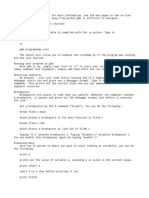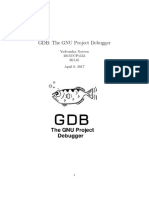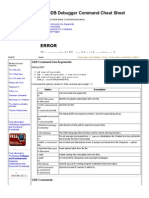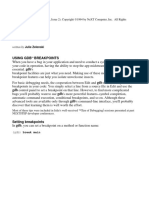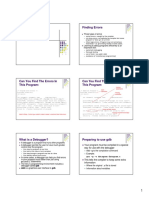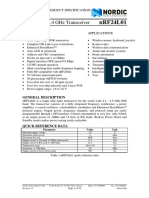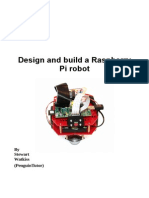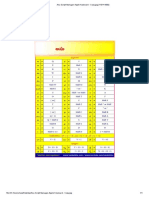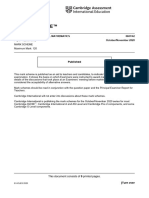Debugging Using GDB PDF
Uploaded by
Trung KiênDebugging Using GDB PDF
Uploaded by
Trung KiênDebugging "C" And "C++" Programs Using "gdb"
Page 1 of 5
[LUPG Home] [Tutorials] [Related Material] [Essays] [Project Ideas] [Send Comments]
Debugging "C" And "C++" Programs Using "gdb"
Table Of Contents: 1. 2. 3. 4. 5. 6. 7. 8. 9. 10. Why Use A Debugger? Invoking the "gdb" Debugger Running A Program Inside The Debugger Setting Breakpoints Stepping A Command At A Time Printing Variables And Expressions Examining The Function Call Stack Attaching To an Already Running Process Debugging A Crashed Program Getting More Info About Debugging
Why Use A Debugger?
This might sound silly, but I've heard of many programmers that claim they do not need a debugger. They simply don't create bugs. Well, one thing is sure - either they've no idea what they are saying, or they just never put their code to real test. Or maybe they're indeed as gifted as they claim. Unfortunately, most of us tend to have bugs in our code. We could use printing commands to test our code, or we could use a debugger. Many times our code might seem to work correctly, because we didn't test it under enough scenarios. Other times we know there's a bug, but by just reading the code we don't notice it is there. Thus, we should develop a habit of launching a debugger when we get into trouble. It shouldn't come instead of making an effort to write correct code, to add many tests in the code for invalid function arguments, NULL pointers, etc. But when we're in trouble, it's probably our best shot. The explanations given here are specific to the "gdb" debugger, since there are no real standards regarding the activation and usage of debuggers, but once you know what features to expect from a debugger, it's not too hard to adapt your knowledge to different debuggers.
Invoking the "gdb" Debugger
Before invoking the debugger. make sure you compiled your program (all its modules, as well as during linking) with the "-g" flag. Otherwise, life will be tough. Lets compile the "debug_me.c" program, and then invoke "gdb" to debug it:
gcc -g debug_me.c -o debug_me gdb debug_me
Note that we run the program from the same directory it was compiled in, otherwise gdb won't find the source file, and thus won't be able to show us where in the code we are at a given point. It is possible to ask gdb to search for extra source files in some directory after launching it, but for now, it's easier to just invoke it from the correct directory.
http://users.actcom.co.il/~choo/lupg/tutorials/debugging/debugging-with-gdb.html
10/26/2013
Debugging "C" And "C++" Programs Using "gdb"
Page 2 of 5
Running A Program Inside The Debugger
Once we invoked the debugger, we can run the program using the command "run". If the program requires command line parameters (like our debug_me program does), we can supply them to the "run" command of gdb. For example:
run "hello, world" "goodbye, world"
Note that we used quotation marks to denote that "hello, world" is a single parameter, and not to separate parameters (the debugger assumes white-space separates the parameters).
Setting Breakpoints
The problem with just running the code is that it keeps on running until the program exits, which is usually too late. For this, breakpoints are introduced. A break point is a command for the debugger to stop the execution of the program before executing a specific source line.We can set break points using two methods: 1. Specifying a specific line of code to stop in:
break debug_me.c:9
Will insert a break point right before checking the command line arguments in our program (see the file supplied with this tutorial). 2. Specifying a function name, to break every time it is being called:
break main
this will set a break point right when starting the program (as the function "main" gets executed automatically on the beginning of any C or C++ program).
Stepping A Command At A Time
So lets see, we've invoked gdb, then typed:
break main run "hello, world" "goodbye, world"
Then the debugger gave something like the following:
Starting warning: warning: warning: program: /usr/home/choo/work/c-on-unix/debug_me Unable to find dynamic linker breakpoint function. GDB will be unable to debug shared library initializers and track explicitly loaded dynamic code.
Breakpoint 1, main (argc=1, argv=0xbffffba4) at debug_me.c:9 9 if (argc < 2) { /* 2 - 1 for program name (argv[0]) and one for a param. */ (gdb)
Note that you won't always get the warnings i got - it just goes to show you how lousy my system setup is. In any case, these warnings are not relevant to our code, as we do not intend to debug any shared libraries.
http://users.actcom.co.il/~choo/lupg/tutorials/debugging/debugging-with-gdb.html
10/26/2013
Debugging "C" And "C++" Programs Using "gdb"
Page 3 of 5
Now we want to start running the program slowly, step by step. There are two options for that: 1. "next" - causes the debugger to execute the current command, and stop again, showing the next command in the code to be executed. 2. "step" - causes the debugger to execute the current command, and if it is a function call - break at the beginning of that function. This is useful for debugging nested code. Now is your time to experiment with these options with our debug program, and see how they work. It is also useful to read the debuggers help, using the command "help break" and "help breakpoints" to learn how to set several breakpoints, how to see what breakpoints are set, how to delete breakpoints, and how to apply conditions to breakpoints (i.e. make them stop the program only if a certain expression evaluates to "true" when the breakpoint is reached).
Printing Variables And Expressions
Without being able to examine variables contents during program execution, the whole idea of using a debugger is quite lost. You can print the contents of a variable with a command like this:
print i
And then you'll get a message like:
$1 = 0
which means that "i" contains the number "0". Note that this requires "i" to be in scope, or you'll get a message such as:
No symbol "i" in current context.
For example, if you break inside the "print_string" function and try to print the value of "i", you'll get this message. You may also try to print more complex expressions, like "i*2", or "argv[3]", or "argv[argc]", and so on. In fact, you may also use type casts, call functions found in the program, and whatever your sick mind could imagine (well, almost). Again, this is a good time to try this out.
Examining The Function Call Stack
Once we got into a break-point and examined some variables, we might also wish to see "where we are". That is, what function is being executed now, which function called it, and so on. This can be done using the "where" command. At the gdb command prompt, just type "where", and you'll see something like this:
#0 #1 print_string (num=1, string=0xbffffc9a "hello") at debug_me.c:7 0x80484e3 in main (argc=1, argv=0xbffffba4) at debug_me.c:23
This means the currently executing function is "print_string", at file "debug_me.c", line 7. The function that called it is "main". We also see which arguments each function had received. If there were more functions in the call chain, we'd see them listed in order. This list is also called "a stack trace", since it shows us the structure of the execution stack at this point in the program's life. Just as we can see contents of variables in the current function, we can see contents of variables local to the calling function, or to any other function on the stack. For example, if we want to see the contents of variable "i" in function "main", we can type the following two commands:
http://users.actcom.co.il/~choo/lupg/tutorials/debugging/debugging-with-gdb.html
10/26/2013
Debugging "C" And "C++" Programs Using "gdb"
Page 4 of 5
frame 1 print i
The "frame" command tells the debugger to switch to the given stack frame ('0' is the frame of the currently executing function). At that stage, any print command invoked will use the context of that stack frame. Ofcourse, if we issue a "step" or "next" command, the program will continue at the top frame, not at the frame we requested to see. After all, the debugger cannot "undo" all the calls and continue from there.
Attaching To an Already Running Process
It might be that we'll want to debug a program that cannot be launched from the command line. This may be because the program is launched from some system daemon (such as a CGI program on the web), and we are too lazy to make it possible to run it directly from the command line. Or perhaps the program takes very long time to run its initialization code, and starting it with a debugger attached to it will cause this startup time to be much much longer. There are also other reasons, but hopefully you got the point. In order to do that, we will launch the debugger in this way:
gdb debug_me 9561
Here we assume that "debug_me" is the name of the program executed, and that 9561 is the process id (PID) of the process we want to debug. What happens is that gdb first tries looking for a "core" file named "9561" (we'll see what core files are in the next section), and when it won't find it, it'll assume the supplied number is a process ID, and try to attach to it. If there process executes exactly the same program whose path we gave to gdb (not a copy of the file. it must be the exact same file that the process runs), it'll attach to the program, pause its execution, and will let us continue debugging it as if we started the program from inside the debugger. Doing a "where" right when we get gdb's prompt will show us the stack trace of the process, and we can continue from there. Once we exit the debugger, It will detach itself from the process, and the process will continue execution from where we left it.
Debugging A Crashed Program
One of the problems about debugging programs, has to do with Murphy's law: A program will crash when least expected. This phrase just means that after you take the program out as production code, it will crash. And the bugs won't necessarily be easy to reproduce. Luckily, there is some aid for us, in the image of "core files". A core file contains the memory image of a process, and (assuming the program within the process contains debug info) its stack trace, contents of variables, and so on. A program is normally set to generate a core file containing its memory image when it crashes due to signals such as SEGV or BUS. Provided that the shell invoking the program was not set to limit the size of this core file, we will find this file in the working directory of the process (either the directory from which it was started, or the directory it last switched to using the chdir system call). Once we get such a core file, we can look at it by issuing the following command:
gdb /path/to/program/debug_me core
This assumes the program was launched using this path, and the core file is in the current directory. If it is not, we can give the path to the core file. When we get the debugger's prompt (assuming the core file was successfully read), we can issue commands such as "print", "where" or "frame X". We can not issue commands that imply execution (such as "next", or the invocation of function calls). In some situations, we will be able to see what caused the crash.
http://users.actcom.co.il/~choo/lupg/tutorials/debugging/debugging-with-gdb.html
10/26/2013
Debugging "C" And "C++" Programs Using "gdb"
Page 5 of 5
One should note that if the program crashed due to invalid memory address access, this will imply that the memory of the program was corrupt, and thus that the core file is corrupt as well, and thus contains bad memory contents, invalid stack frames, etc. Thus, we should see the core file's contents as one possible past, out of many probable pasts (this makes core file analysis rather similar to quantum theory. almost).
Getting More Info About Debugging
It is now probably time to go play around with your programs and your debugger. It is suggested to try "help" inside gdb, to learn more about its commands. Especially the "dir" command, that enables debugging programs whose source code is split over several directories. Once you feel that gdb is too limiting, you can try out any of various graphical debuggers. Try to check if you have "xxgdb" installed - this is a graphical interface running on top of gdb. If you find it too ugly, you can try out "ddd". Its main advantage over xxgdb is that it allows you to graphically view the contents of pointers, linked lists and other complex data structures. It might not be installed on your system, and thus you'll need to download it from the network. If you're running on a SunOs or Solaris environment, there is a program named "gcore", that allows taking the core of a running process, without stopping it. This is useful if the process is running in an infinite loop, and you want to take a core file to keep aside, or you want to debug a running process without interrupting it for too long.
[LUPG Home] [Tutorials] [Related Material] [Essays] [Project Ideas] [Send Comments] This document is copyright (c) 1998-2002 by guy keren. The material in this document is provided AS IS, without any expressed or implied warranty, or claim of fitness for a particular purpose. Neither the author nor any contributers shell be liable for any damages incured directly or indirectly by using the material contained in this document. permission to copy this document (electronically or on paper, for personal or organization internal use) or publish it on-line is hereby granted, provided that the document is copied as-is, this copyright notice is preserved, and a link to the original document is written in the document's body, or in the page linking to the copy of this document. Permission to make translations of this document is also granted, under these terms - assuming the translation preserves the meaning of the text, the copyright notice is preserved as-is, and a link to the original document is written in the document's body, or in the page linking to the copy of this document. For any questions about the document and its license, please contact the author.
http://users.actcom.co.il/~choo/lupg/tutorials/debugging/debugging-with-gdb.html
10/26/2013
You might also like
- Testing and Debugging: Jithin Jacob Lecturer Dept of CSE, MACENo ratings yetTesting and Debugging: Jithin Jacob Lecturer Dept of CSE, MACE14 pages
- GNU Debugger (GDB) : Computing LaboratoryNo ratings yetGNU Debugger (GDB) : Computing Laboratory10 pages
- LAB - Chapter 3.1 - Software Security - GDB - ExNo ratings yetLAB - Chapter 3.1 - Software Security - GDB - Ex8 pages
- CS61B P. N. Hilfinger Spring 1998: Basic Functions of A DebuggerNo ratings yetCS61B P. N. Hilfinger Spring 1998: Basic Functions of A Debugger5 pages
- Debugging Techniques:: GNU GDB: Breakpoints Where You Want The The Execution To Stop. This Can Be SpecifiedNo ratings yetDebugging Techniques:: GNU GDB: Breakpoints Where You Want The The Execution To Stop. This Can Be Specified1 page
- Debugging A C++ Program Under Unix: GDB TutorialNo ratings yetDebugging A C++ Program Under Unix: GDB Tutorial6 pages
- Linux Tutorial - GNU GDB Debugger Command Cheat SheetNo ratings yetLinux Tutorial - GNU GDB Debugger Command Cheat Sheet8 pages
- GDB Command Line Arguments:: Option DescriptionNo ratings yetGDB Command Line Arguments:: Option Description6 pages
- Finding Errors: 57:017, Computers in Engineering Using GDB and DDDNo ratings yetFinding Errors: 57:017, Computers in Engineering Using GDB and DDD4 pages
- C# Programming Illustrated Guide For Beginners & Intermediates: The Future Is Here! Learning By Doing ApproachFrom EverandC# Programming Illustrated Guide For Beginners & Intermediates: The Future Is Here! Learning By Doing ApproachNo ratings yet
- CMP Books - Practical Statechartsewsdf in C&C++ Quantum Programming For Embedded SystemsNo ratings yetCMP Books - Practical Statechartsewsdf in C&C++ Quantum Programming For Embedded Systems279 pages
- Design and Build A Raspberry Pi Robot: by Stewart Watkiss (Penguintutor)No ratings yetDesign and Build A Raspberry Pi Robot: by Stewart Watkiss (Penguintutor)71 pages
- A Stable Tracking Control Method For An Autonomous Mobile Robot PDF100% (1)A Stable Tracking Control Method For An Autonomous Mobile Robot PDF6 pages
- A Stable Tracking Control Method For An Autonomous Mobile Robot PDF100% (1)A Stable Tracking Control Method For An Autonomous Mobile Robot PDF6 pages
- Factors Impact Accounting Information System PerformanceNo ratings yetFactors Impact Accounting Information System Performance7 pages
- Multimedia 3D Modelling and Animation: STMIK AKBA Makassar 2017No ratings yetMultimedia 3D Modelling and Animation: STMIK AKBA Makassar 2017152 pages
- Tribology International: M. Amarnath, I.R. Praveen KrishnaNo ratings yetTribology International: M. Amarnath, I.R. Praveen Krishna11 pages
- Request For Application and TOR For Connected Bangladesh ProjectNo ratings yetRequest For Application and TOR For Connected Bangladesh Project29 pages
- Oriental Institute of Science and TechnologyNo ratings yetOriental Institute of Science and Technology9 pages
- Download full Fuzzy System Identification and Adaptive Control Communications and Control Engineering Ruiyun Qi Gang Tao Bin Jiang ebook all chapters100% (1)Download full Fuzzy System Identification and Adaptive Control Communications and Control Engineering Ruiyun Qi Gang Tao Bin Jiang ebook all chapters40 pages
- Cambridge IGCSE™: Cambridge International Mathematics 0607/42 October/November 2020No ratings yetCambridge IGCSE™: Cambridge International Mathematics 0607/42 October/November 20209 pages
- CV-Sagar-Instrumentation-10 Yrs Exp - 221108 - 130459No ratings yetCV-Sagar-Instrumentation-10 Yrs Exp - 221108 - 1304594 pages




